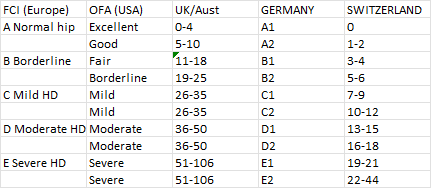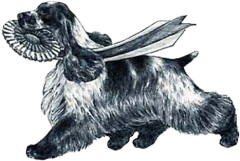Hip Dysplasia (HD)
last updated November 2024
Hip Dysplasia (abnormal development of the hip joint) is most common in dogs that grow larger and more quickly than others. But it can be found in any breed, including Cocker Spaniels.
Dogs with a genetic predisposition for Hip Dysplasia are more likely to be affected. Hip Dysplasia is the defective development of the hip joints. It is therefore a developmental disease, (not congenital), with polygenic inheritance.
The external environmental factors such as rapid growth during adolescence, increased body weight, excessive physical load or an overdose of calcium in the diet, contribute to its formation.
- Genetic predisposition:
- Rapid Growth/Weight
Rapid growth during adolescence, increased body weight - Nutritional factors: Feeding puppies an incorrect diet may have a detrimental effect on the development of the hip joint. Diets that are rich in calories, fat, and calcium (* Take care feeding in supplements, Not enough can be as problematic as too much of some minerals)
- Pelvic-muscle mass
- Over-exercise: Dogs that were over-exercised as puppies may have an increased risk, especially if already predisposed.
The hip joint is known as a ball and socket joint. The ball is the femoral head (hind leg bone), while the socket is located in the pelvis. The ball and socket in a typical hip joint are precisely fitted to each other, like jigsaw pieces. For stability, connective tissues and ligaments hold the ball securely in the socket of the hip, allowing it to move smoothly and in multiple directions.
In a dog affected by hip dysplasia, the head of the femur does not fit properly in the socket because of structural defects. This creates a looseness in the joint and, over time, cartilage damage.
HD is a progressive and irreversible disease.
It can cause lameness & pain in severe cases or produces no noticeable symptoms in some cases.
HD Articles
The Cocker Spaniel is not included on the list of
"At Risk Breeds"
HD is being monitored in the UK to determine if there is a problem. A relatively small number (in comparison to the total number of annual registrations) of Cockers in the UK have been hip-scored to date producing a current breed median score of 10.
HD Around The World
World Hip Scheme Scoring
(Approximate Correlation)

Research Notes on HD
breed health requirements.
The effects of positioning, reason for screening and the referring veterinarian on prevalence estimates of canine hip dysplasia
In a young animal with developing hip dysplasia, increased laxity of the structures supporting the hip joint result in the joint becoming unstable. Joint instability results in further abnormal development of the hip joint, with the femoral head (“ball” at the top of the femur) becoming flattened, and the acetabulum (“socket” of the pelvis) becoming shallow so that the femoral head is not properly located within the socket. Over time, the cartilage covering the femoral head and acetabulum becomes damaged, and osteoarthritis develops.
Neutering Age & hip dysplasia
There is some controversy about the effect of spaying/neutering before puberty. Male dogs rely on testosterone to stop bone growth and early neutered males will grow taller as their bones grow for a longer period if testosterone is removed early. This may lead to a predisposing disparity in the growth of bone and muscle. There appear to be predisposing factors for early spay as well, assuming the dog has the genetic predisposition. How much added predisposition comes with early spay/neuter and for which breeds remains controversial. In one study, it was found that neutering before age 5.5 months was associated with a 6.7% incidence of hip dysplasia while neutering after age 5.5 months was associated with a 4.7% incidence of hip dysplasia.
Breeds Known To Be Effected By HD
This list doesn’t include every breed that’s affected. In some countries Bulldogs and Pugs are highly at risk. Hip dysplasia can develop in any pure bred or crossbred dog.
Airedale Terrier, Basset Hound, Bernese Mountain Dog, Bloodhound, Bullmastiff, Chesapeake Bay Retriever, Chow Chow, Dogue de Bordeaux, English Setter, French Bulldog, German Shepherd, Golden Retriever, Gordon Setter, Great Dane, Labrador Retriever, Neapolitan Mastiff, Otterhound, Puig, Rottweiler, Russian Black Terrier, Samoyed, St Bernard, Welsh Springer Spaniel,
Informal data collected from RKC, ANKC, OFA
Data lasted updated


